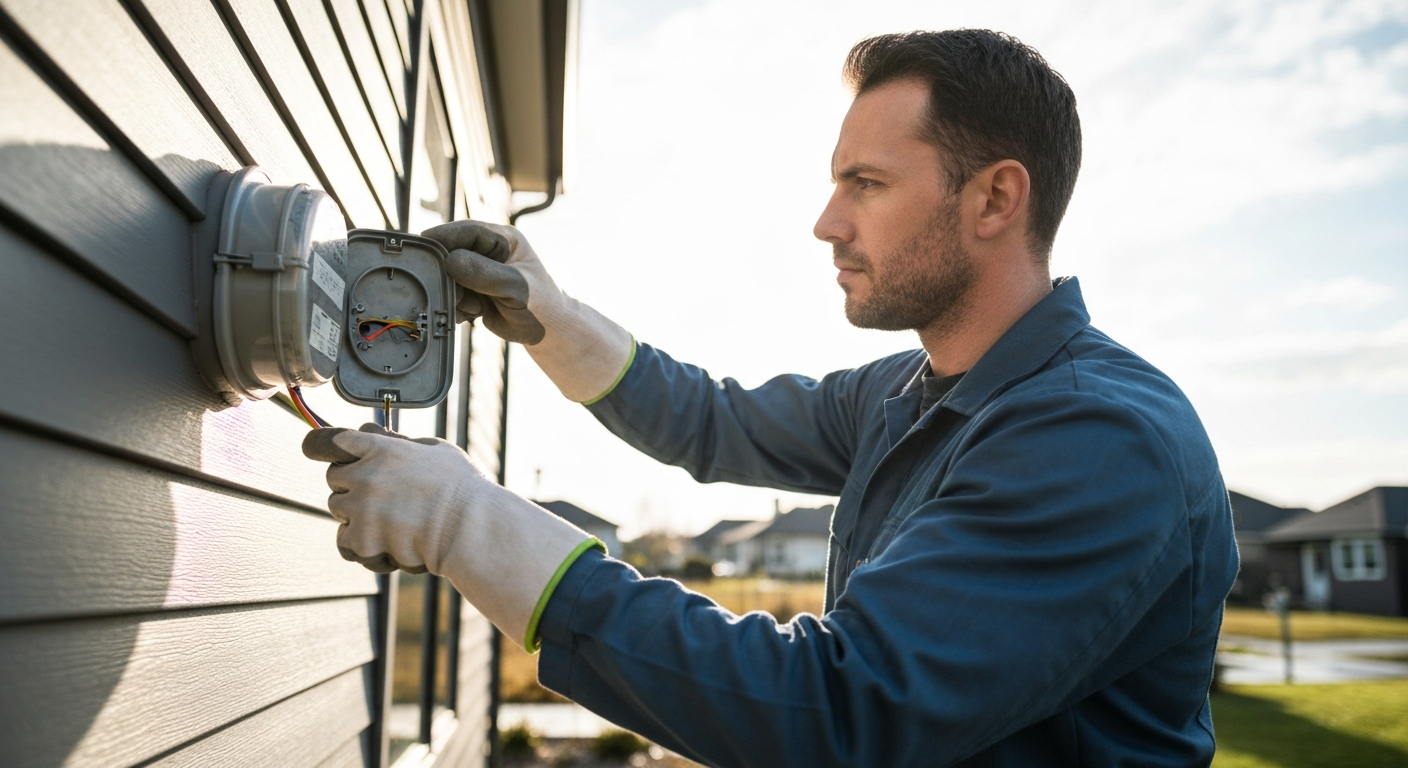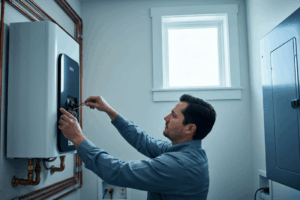
Who is Responsible for the Electric Meter Base?
You get the call on a Monday morning. A homeowner is in a panic. A tree limb came down during last night’s storm, tearing the service drop from their house and ripping the meter enclosure clean off the wall. Wires are dangling, the power is out, and they have one crucial question: “Who is supposed to fix this?” As a licensed electrician, you know the answer isn’t always as simple as it seems. It’s a classic scenario that hinges on a critical, and often misunderstood, concept in our trade. So, who is responsible for the meter base? Answering this question confidently not only makes you a hero to your client but also solidifies your expertise and authority in a situation fraught with confusion and safety concerns.
This gray area of responsibility is one of the most common points of confusion for homeowners, and even for some newer electricians. Understanding where the utility’s job ends and the customer’s begins is fundamental to service work. Let’s break it down.
The All-Important Utility Demarcation Point
The entire question of electrical service ownership revolves around a single concept: the utility demarcation point. This is the physical point where the electric utility’s equipment and responsibility end, and the privately owned customer-owned equipment begins. Think of it as the property line of the electrical service.
Typically, for an overhead service, this point is the weatherhead or the point of attachment where the utility’s service drop connects to the building. For an underground service using a service lateral, the demarcation point is often at the terminals within the meter socket itself. Everything on the utility side of this line is their problem. Everything on the customer’s side is their responsibility to maintain and repair—and that’s where you, the electrician, come in.
Line Side vs. Load Side: Drawing the Line of Responsibility
To understand the demarcation point in practical terms, you need to be fluent in the language of line side vs load side. This distinction is the bedrock of meter socket responsibility.
- Line Side: This refers to all wiring and equipment that comes *before* or *up to* the electric meter. These are the energized conductors coming from the utility’s transformer. The utility is responsible for the service drop or lateral conductors that connect to the meter socket.
- Load Side: This refers to all wiring and equipment that comes *after* the electric meter. This includes the conductors leaving the meter, the main breaker panel, and all the branch circuits throughout the property. This is the customer’s domain.
This separation is about more than just billing; it’s about safety, maintenance, and legal liability. Working on the line side without utility authorization is incredibly dangerous and strictly forbidden.
So, Who Has Meter Can Ownership?
Here we arrive at the heart of the matter. The utility owns and is responsible for the glass-enclosed meter itself—the device that measures consumption. However, in the vast majority of jurisdictions across the United States, the meter base (also known as the meter socket or “meter can”) is considered customer-owned equipment.
This means if you encounter a damaged meter socket—whether from corrosion, physical impact, or overheating—the property owner is responsible for hiring a licensed electrician to perform the meter base replacement. This is a critical piece of information that you can provide to clients to clarify the situation and outline the necessary next steps.
Your Role in Service-Related Repairs and Upgrades
As the expert on site, your role extends beyond simply replacing parts. When a meter base is compromised, you are the project manager. This typically involves:
- Assessing the full scope of damage: This includes the service mast and riser, the attachment points, and the service entrance conductors that run from the weatherhead to the meter socket.
- Determining if an electrical service upgrade is needed: A damaged meter base is often the perfect opportunity for a homeowner to upgrade their service from 100A to 200A, a common and valuable project for any electrical contractor.
- Ensuring all work complies with the code: All service entrance work falls under the strict guidelines of NEC Article 230, which covers everything from conductor sizing to clearances. Staying current on the latest 2023 NEC changes is essential for compliance and safety.
Navigating a Meter Base Replacement Project
Successfully completing a meter base replacement requires more than just technical skill; it demands careful coordination. A key part of the job is managing the utility disconnect reconnect policy. You cannot simply pull a meter to de-energize the socket. This requires scheduling a formal disconnect with the utility company.
The process generally looks like this:
- Coordinate the Disconnect: You or your office staff will contact the utility to schedule a time for them to come out and disconnect power at the pole or pedestal and remove the meter.
- Perform the Replacement: With the power safely disconnected, you can replace the meter socket, mast, and any other damaged components. This is also when you’ll ensure the new socket meets all current utility service requirements. They often have specific lists of approved equipment and installation standards that go beyond the NEC.
- Call for Inspection: Once your work is complete, it must be inspected by the local AHJ (Authority Having Jurisdiction).
- Schedule the Reconnect: After the inspection passes, you coordinate with the utility once more. They will return to install the new meter, re-energize the service, and apply their seal.
When selecting the new base, you have to consider more than just the service amperage. You need to know, for instance, how big is a meter base required to be to accommodate the utility’s specific meter type and any potential future upgrades. This foresight demonstrates true expertise. For those looking to deepen their knowledge, mastering electrical service installations is a valuable skill set that sets you apart in the field.
To truly master these complex projects and understand the full scope of a service installation, check out the resources available from ExpertCE.
Why This Knowledge Matters for Your Career
Being the go-to expert on topics like meter can ownership and service requirements is invaluable. When a panicked client calls, you can confidently and calmly explain the process, the responsibilities, and the costs involved. This builds immense trust and often turns a one-off emergency call into a long-term customer relationship. This knowledge is a cornerstone of advancing your electrical career from a technician to a trusted advisor.
By understanding the nuances of the utility demarcation point and the roles of each party, you position yourself as a true professional who can safely and efficiently navigate one of the most critical parts of any electrical system.
Frequently Asked Questions (FAQs)
Can a homeowner replace their own meter base?
Absolutely not. This is extremely dangerous work that involves energized line-side conductors. A meter base replacement must be performed by a licensed electrician who can coordinate with the utility for a safe disconnect and ensure the installation meets all NEC and local utility standards.
Does the utility company have to approve the new meter base I install?
Yes. Every utility has a list of approved meter sockets. Installing a non-approved socket will result in a failed inspection and the utility will refuse to install the meter. It’s critical to check the specific utility service requirements for your area before purchasing or installing any equipment.
What’s the difference between a meter base and a meter socket?
In the field, the terms “meter base,” “meter socket,” and “meter can” are used interchangeably. They all refer to the metal enclosure that houses the utility’s electric meter and contains the connection points for the line-side and load-side conductors.
Image Alt Text: An electrician inspecting an electrical meter base on the side of a residential house.
Disclaimer: The information provided in this educational content has been prepared with care to reflect current regulatory requirements for continuing education. However, licensing rules and regulations can vary by state and are subject to change. While we strive for accuracy, ExpertCE cannot guarantee that all details are complete or up to date at the time of reading. For the most current and authoritative information, always refer directly to your state’s official licensing board or regulatory agency.



